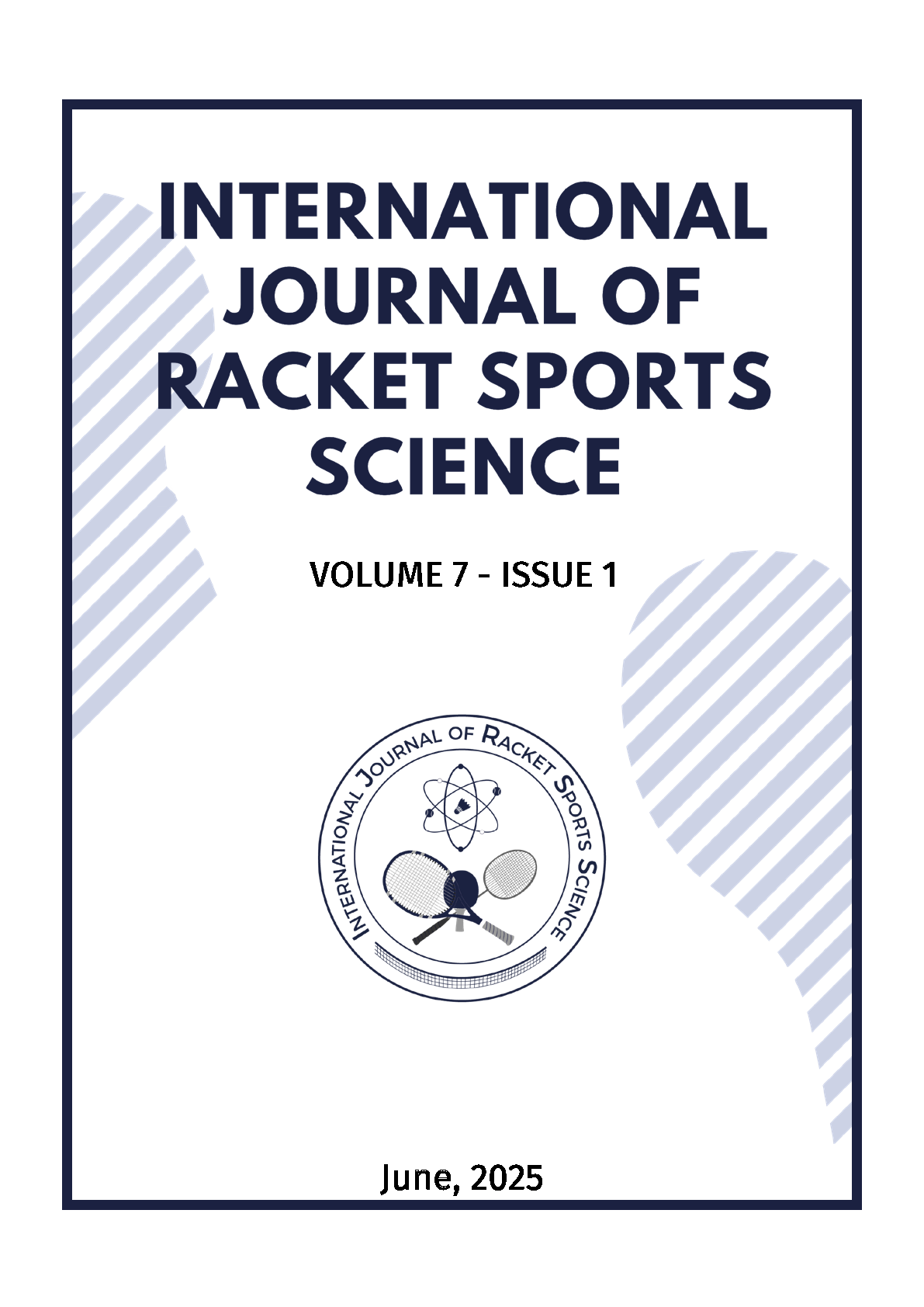Tennis Doubles development: Two historical snapshots show enormous tactical changes at the professional level over 20 years
Abstract
We aimed to compare tactical characteristics in professional men´s tennis doubles by notational analysis of two historical samples of matches collected at least 20 years apart. Samples were taken either between 1985 and 1990 (D<1990: 57 matches, 9.305 points, 34.428 strokes) or in 2011 (D>2010: 8 matches, 1.002 points, 4.297 strokes) during official ATP tournaments. Players were internationally ranked (D<1990: 76 ± 89; D>2010: 102 ± 91) and all matches were played on clay courts following ITF rules. Notational analysis was done by tagging video recordings following the same self-programmed notation software model. Absolute and percentage numbers of stroke rates, winners, and errors as well as specific tactics for services (e. g. Serve & Volley), returns (e. g. Chip & Charge), volleys and groundstrokes (e. g. positioning) were analysed. Coding was done by two experienced tennis coaches. Interrater reliability was calculated by Cohen ́s Kappa and items with r < 0.9 were excluded. Differences between D<1990 and D>2010 were calculated by independent t-tests. Significance level was set at p<0.05. Rally length (3.7±0.3 vs. 4.2±0.5 strokes per point, p<0.001) increased significantly from D<1990 to D>2010. The percentage of serves (32.5±3.9 vs. 23.8±3.5 %) and volleys (25.1±4.0 vs. 17.3±5.7 %) decreased while the percentage of groundstrokes increased over time (8.8±3.6 vs. 26.9±7.0 %) (p<0.001). Serve & Volley application was reduced to one third in D>2010 (98.7±2.0 % vs 33.9±33.4 %) with a high individual variation. Positioning of Returns (more often behind the baseline) and volleys (shorter distance to the net) changed in D>2010 (p<0.001). Tactical characteristics in men´s tennis doubles completely changed within a time frame of 20 years mainly attributed to a decreased Serve & Volley application from most but not from all double players. The current variability in technical and tactical demands must be considered by individualized coaching guidelines.
References
Association of Tennis Professionals [ATP]. (2024). ATP 2024 Tournaments. https://www.atptour.com/en/scores/current/halle/500/draws?matchtype=doubles
Black, W., & Van de Braam, M. (2012). The Modern Game of Doubles: A tactical perspective. ITF coaching & sport science review, 20(56), 18–21. https://doi.org/10.52383/itfcoaching.v20i56.403
Borderias, M., Iglesias, X., Martínez-Gallego, R., & Baiget, E. (2024). Comparison of the finishing shot and ending zone of points in Grand Slam matches of women's doubles tennis: A cross-sectional study. PloS one, 19(5), e0303437. https://doi.org/10.1371/journal.pone.0303437
Carboch, J., & Kocib, T. (2015). A comparison of service efficiency between players of male and female doubles at professional tennis tournaments. Acta kinanthropologica, 51(2), 56-62. https://doi.org/10.14712/23366052.2015.32
Carboch, J., Kocib, T., & Pechacova, M. (2014). Analysis of tactical variants in men’s and women’s tennis doubles on the international level. Asian journal of science and technology, 5(3), 204-207.
Cohen, J. (1968). Weighted kappa: nominal scale agreement provision for scaled disagreement or partial credit. Psychological bulletin, 70(4), 213-220.
Fernandez-Fernandez, J., Kinner, V., & Ferrauti, A. (2010). The physiological demands of hitting and running in tennis on different surfaces. Journal of strength and conditioning research, 24(12), 3255-3264. https://doi.org/10.1519/JSC.0b013e3181e8745f
Ferrauti, A. (1992). Tennis-Doppel und Spielerbeobachtung. Czwalina: Ahrensburg bei Hamburg.
GraphPad (2024). T test calculator. https://www.graphpad.com/quickcalcs/ttest2/.
International Tennis Federation [ITF]. (2024). ITF world tour men’s calendar. https://www.itftennis.com/en/tournament-calendar/mens-world-tennis-tour-calendar/?categories=All&startdate=2024-06
Kocib, T., Carboch, J., Cabela, M., & Kresta, J. (2020). Tactics in tennis doubles: analysis of the formations used by the serving and receiving teams. International journal of physical education, fitness and sports, 9(2), 45-50. https://doi.org/ 10.34256/ijpefs2026
Lausic, D., Tennebaum, G., Eccles, D., Jeong, A., & Johnson, T. (2009). Intrateam communication and performance in doubles tennis. Research quarterly for exercise and sport, 80(2), 281-290. https://doi.org/10.1080/02701367.2009.10599563
Martinez-Gallego, R., Crespo, M., Ramón-Llin, J., Micó, S., & Guzmán, J. F. (2020). Men’s doubles professional tennis on hard courts: Game structure and point ending characteristics. Journal of human sport and exercise, 15(3), 633-642. https://doi.org/10.14198/jhse.2020.153.13
Martinez-Gallego, R., Ramón-Llin, J., & Crespo, M. (2021a). A cluster analysis approach to profile men and women’s volley positions in professional tennis matches (Doubles). Sustainability, 13, 6370. https://doi.org/10.3390/su13116370
Martinez-Gallego, R., Vives, F., Guzmán, J. F., Ramón-Llin, J., & Crespo, M. (2021b). Time structure in men’s professional doubles tennis: does team experience allow finishing the points faster? International journal of performance analysis in sport, 21(2), 215-225. https://doi.org/10.1080/24748668.2021.1872218
Martinez-Gallego, R., Crespo, M., & Jiménez, J. (2021c). Analysis of the differences in serve effectiveness between Billie Jean King Cup (former Fed Cup) and Davis Cup doubles tennis matches. International journal of sports science & coaching, 16(3), 777-783. https://doi.org/10.1177/1747954120988545
Pollard, G., & Pollard, G. (2010). The efficiency of tennis doubles scoring systems. Journal of sports science & medicine, 9(3), 393-397.
Roetert, P. & Groppel, J. (2001). World-Class Tennis Technique. Human Kinetics.
Schmidhofer, S., Leser, R., & Ebert, M. (2014). A comparison between the structure in elite tennis and kids’ tennis on scaled courts (Tennis 10s). International journal of performance analysis in sport, 14(3), 829-840. https://doi.org/10.1080/24748668.2014.11868761
Copyright (c) 2025 International Journal of Racket Sports Science

This work is licensed under a Creative Commons Attribution 4.0 International License.










_(1).png)
